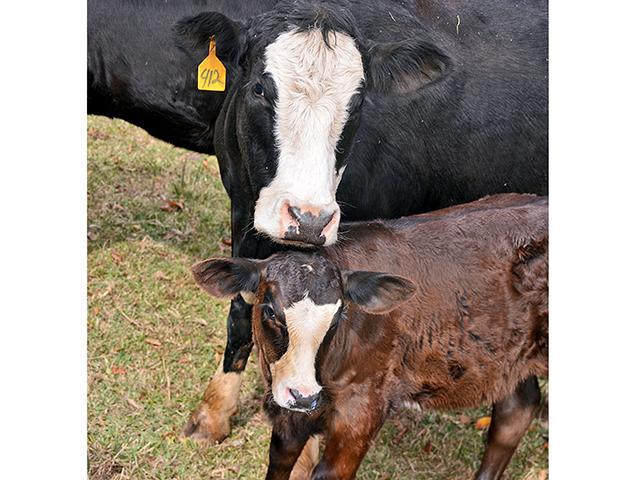Ask the Vet
Clear Up Prolapse Differences
READER: What is the difference between a vaginal and a cervical prolapse in cattle?
Dr. McMillan: I would say it's a question of degree more than anything, and that includes when we are referring to cervicovaginal prolapses
A vaginal prolapse is an eversion of the vagina through the vulva. This results in discomfort and often irritation, which leads to more straining and more tissue being exposed until, in some cases, the cervix is exposed. At that point, it would be classified as a cervical prolapse. Many times, the bladder is included in this prolapse, and in some cases, the straining may lead to a rectal prolapse.
Cervicovaginal prolapses are most common around calving, as hormones associated with birth increase and cause relaxation on the tissues in the pelvis in preparation for birth. Increased abdominal pressure from the near-term calf, intra-abdominal fat and rumen distension are also factors.
There is a strong genetic component, and cows that have a cervicovaginal prolapse are likely to do it again and should be sold. Heifers from these cattle should be watched closely.
While this can occur after calving, when cattle come into heat and even (though rarely) in open, early and midterm cattle, it most commonly occurs before birth. With this condition, the chance of dystocia (difficult birth) is always increased.
With mild cases and especially those that do not stay out, the cow may calve with no problem. More severe cases need to have the prolapse corrected and usually a retaining suture or sutures of some kind to prevent recurrence.
P[L1] D[0x0] M[300x250] OOP[F] ADUNIT[] T[]
Unless drugs with withdrawal times are given, these cattle can be sold, but often there is a heavy discount on them.
If they are very close to calving, they can be induced into labor and watched closely over the next 48 to 72 hours. When the cow goes into labor, sutures need to be cut, and you must be ready to give assistance if problems occur.
Even with a successful delivery, these cattle may reprolapse and, in some cases, especially with a difficult birth, they may have a uterine prolapse, where the whole uterus is exposed. This is always an emergency when it happens for any reason.
READER: We have an indoor cat that is chewing on things in the house, including electrical cords. Our barn cats don't seem to have this issue. The house cat is one our daughter brought in and turned into a pet. How can I stop her from chewing on these cords?
Dr. McMillan: I am not sure we've ever answered a cat question in this column, but here goes.
In my experience, and I do treat cats in our practice, behavioral issues are much more common with indoor cats. This chewing of electrical cords can be a dangerous habit to both you and the cat, and you're wise to be concerned.
There can be many reasons cats chew on objects. Dental issues can cause it. Kittens shedding baby teeth or mature cats with periodontal disease are prone to this behavior. Also, cats suffering from even mild nutritional deficiencies may chew on objects in an attempt to balance their diets.
Cats are natural predators, and they often become bored when confined indoors. That can lead to stress and unwanted behaviors. Some cats, especially breeds like the Siamese and Burmese (or crosses of these), can develop obsessive-compulsive behaviors.
To deal with this issue, start with a complete exam by your veterinarian. Include blood work to be sure there are no internal issues creating this problem, and have a nutritional assessment done. Periodontal disease, if present, can be resolved by cleaning the cat's teeth, and home dental care can help slow its recurrence. Even things like arthritis and pain are often unappreciated causes of problems in cats.
Assuming no physical issues are identified, what next? Start by eliminating any unnecessary cords, and mount dangling cords (which are especially tempting for cats to play with). Go wireless where you can.
Cover exposed cords with cord protectors, available at electronic, home and office supply stores. Apply an aversive substance to the cords and any other objects the cat is chewing on -- bitter apple, Vicks, lime or lemon juice, chili oil, lavender oil, cayenne pepper and hot sauce are some successful options people have used. Also, consider applying double-sided tape to the cords.
For more information on helping your indoor cat live a better life, visit Ohio State University, the Indoor Cat Initiative, at https://indoorpet.osu.edu/…
**
-- Please contact your veterinarian with questions pertaining to the health of your herd. Every operation is unique, and the information in this column does not pertain to all situations. This is not intended as medical advice but is purely for informational purposes.
-- Write Dr. Ken McMillan at Ask The Vet, 2204 Lakeshore Dr., Suite 415, Birmingham, AL 35209, or email vet@progressivefarmer.com
[PF_0222]
(c) Copyright 2022 DTN, LLC. All rights reserved.




